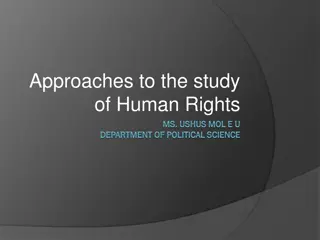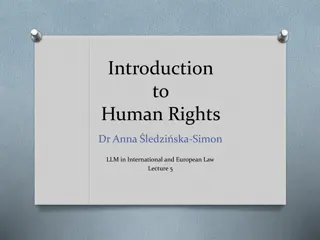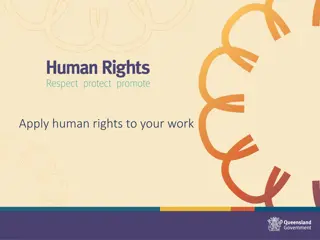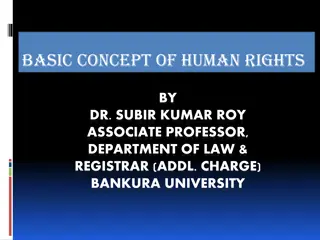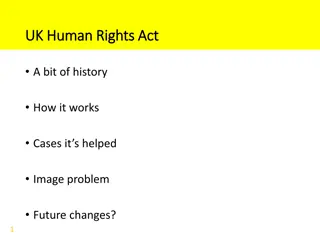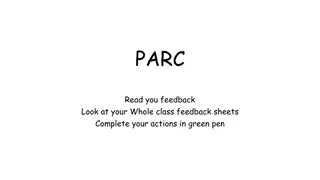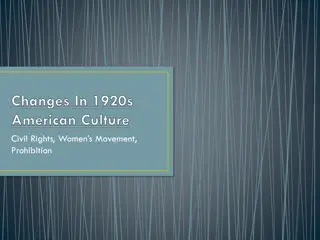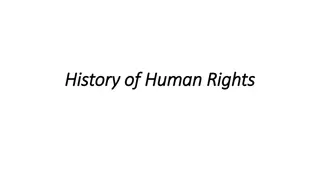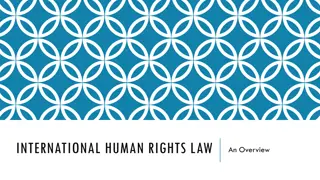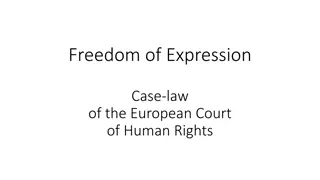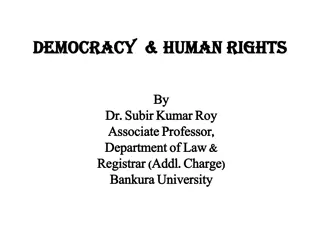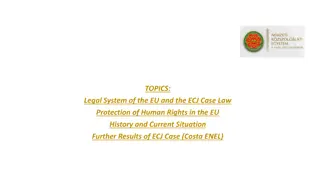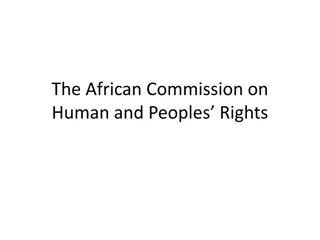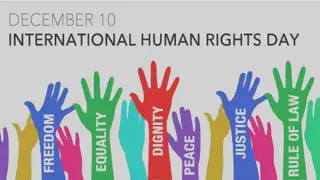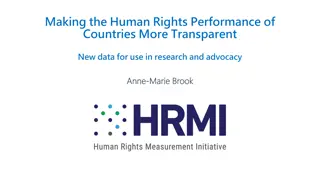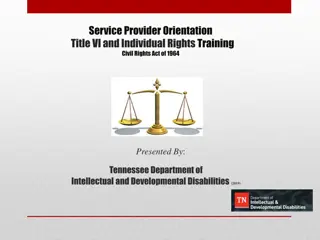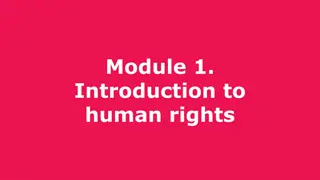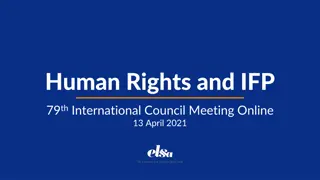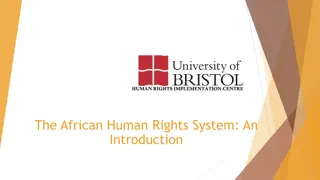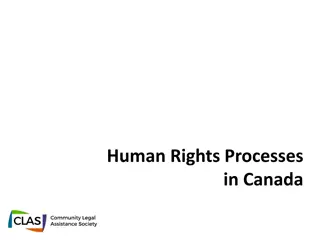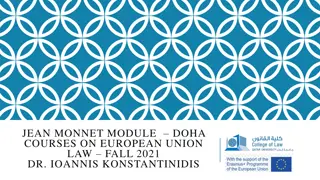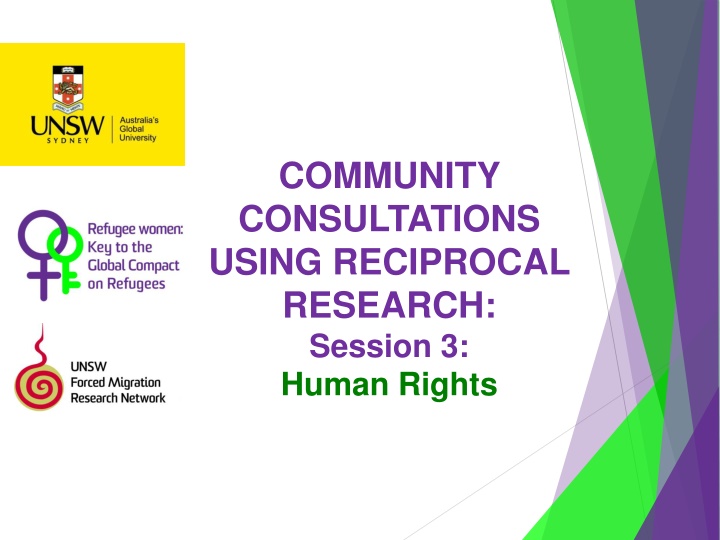
Human Rights Framework: What They Mean to Us
The human rights framework encompasses laws, conventions, and declarations established by the United Nations to protect the rights of individuals worldwide. Human rights are universal, indivisible, and inalienable, belonging to everyone regardless of social characteristics. Explore the significance of human rights in today's society through international agreements and legal documents.
Download Presentation

Please find below an Image/Link to download the presentation.
The content on the website is provided AS IS for your information and personal use only. It may not be sold, licensed, or shared on other websites without obtaining consent from the author. If you encounter any issues during the download, it is possible that the publisher has removed the file from their server.
You are allowed to download the files provided on this website for personal or commercial use, subject to the condition that they are used lawfully. All files are the property of their respective owners.
The content on the website is provided AS IS for your information and personal use only. It may not be sold, licensed, or shared on other websites without obtaining consent from the author.
E N D
Presentation Transcript
COMMUNITY CONSULTATIONS USING RECIPROCAL RESEARCH: Session 3: Human Rights
Human Rights: What they mean to us Intellectual property of E Pittaway and L. Bartolomei; Reuse is permitted with author attribution Intellectual property of E Pittaway and L. Bartolomei; Reuse is permitted with author attribution
What is the United Nations? Intellectual property of E Pittaway and L. Bartolomei; Reuse is permitted with author attribution
What is the Human Rights Framework? The United Nations has produced many international conventions, declarations and legal documents which list our human rights. These laws and documents together make up the human rights framework. When Governments sign these documents and conventions they are agreeing to respect these human rights. Intellectual property of E Pittaway and L. Bartolomei; Reuse is permitted with author attribution
What are human rights? These are the rights to which all people are entitled regardless of race, gender, religion, age or any other social characteristic. They are universal - this means they belong to everyone, everywhere. Intellectual property of E Pittaway and L. Bartolomei; Reuse is permitted with author attribution
What are human rights? They are indivisible, which means that all human rights are of equal importance. They are inalienable, which means that although someone may stop you having them, they are still your rights. Intellectual property of E Pittaway and L. Bartolomei; Reuse is permitted with author attribution
Universal Declaration of Human Rights International Covenant on Economic, Social and Cultural Rights International Covenant on Civil and Political Rights Intellectual property of E Pittaway and L. Bartolomei; Reuse is permitted with author attribution
Economic, Social and Cultural Rights Food, water, shelter Health care Education The right to family Access to income and the right to work The right to religion The right to enjoy the cultural life of your community Intellectual property of E Pittaway and L. Bartolomei; Reuse is permitted with author attribution
Civil and political rights Access to the law Political freedom Access to income The right not to be tortured To live without persecution The right to seek asylum The right to work free from exploitation, The right to life, to security, to freedom Freedom of movement The right not to be forced into a marriage Intellectual property of E Pittaway and L. Bartolomei; Reuse is permitted with author attribution
Obstacles to human rights Political challenges State sovereignty & lack of political will Ideological challenges Universality versus cultural relativism Individual or collective rights Women s and girls human rights Gender neutral or gender blind Intellectual property of E Pittaway and L. Bartolomei; Reuse is permitted with author attribution
The Universal Declaration of Human Rights Intellectual property of E Pittaway and L. Bartolomei; Reuse is permitted with author attribution
Intellectual property of E Pittaway and L. Bartolomei; Reuse is permitted with author attribution
Autonomy and self determination Intellectual property of E Pittaway and L. Bartolomei; Reuse is permitted with author attribution
Shelter, food and water Intellectual property of E Pittaway and L. Bartolomei; Reuse is permitted with author attribution
The right to live with family Intellectual property of E Pittaway and L. Bartolomei; Reuse is permitted with author attribution
The right to live in freedom from all forms of violence Intellectual property of E Pittaway and L. Bartolomei; Reuse is permitted with author attribution
The right to good health care Intellectual property of E Pittaway and L. Bartolomei; Reuse is permitted with author attribution
The right to full and equal access to the law Intellectual property of E Pittaway and L. Bartolomei; Reuse is permitted with author attribution
The right to freedom of speech Intellectual property of E Pittaway and L. Bartolomei; Reuse is permitted with author attribution
The right to education for girls and boys - and also for life-long education Intellectual property of E Pittaway and L. Bartolomei; Reuse is permitted with author attribution
The right to social security, equal access to resources, and to work Intellectual property of E Pittaway and L. Bartolomei; Reuse is permitted with author attribution
The right to freedom of religion and religious expression Intellectual property of E Pittaway and L. Bartolomei; Reuse is permitted with author attribution
The right to political freedom and representation by both men and women Intellectual property of E Pittaway and L. Bartolomei; Reuse is permitted with author attribution
The human rights necklace Each coloured bead represents a group of our rights. The closed circle of the necklace symbolises the equal value of each right and the indivisibility and inalienability of rights. Refugees are often given a packet off beads and twine to make a symbolic necklace of their rights as an exercise. This story demonstrates what this can mean to them Intellectual property of E Pittaway and L. Bartolomei; Reuse is permitted with author attribution
Refugees have rights! Intellectual property of E Pittaway and L. Bartolomei; Reuse is permitted with author attribution
All refugees have a right to full protection from all forms of human rights violations. Their rights are set out in the 1951 Refugee Convention, its 1967 Protocol (and the Universal Declaration of Human Rights). Intellectual property of E Pittaway and L. Bartolomei; Reuse is permitted with author attribution
Children have rights! Their rights are set out in the Convention on the Rights of the Child (CROC) (and the Universal Declaration of Human Rights) . Intellectual property of E Pittaway and L. Bartolomei; Reuse is permitted with author attribution
Childrens rights The right to go to school The right to be with their parents The right to have fun The right not to have to work like an adult The right to go to a doctor The right to protection from sexual abuse The right to be protected from drugs The right to be safe to live and grow in safety The right to not be recruited as a soldier or to fight in a conflict in a conflict to fight Intellectual property of E Pittaway and L. Bartolomei; Reuse is permitted with author attribution
The right of every child to live in security with their family. Intellectual property of E Pittaway and L. Bartolomei; Reuse is permitted with author attribution
The right of every child not to be conscripted as a child soldier or sex slave Intellectual property of E Pittaway and L. Bartolomei; Reuse is permitted with author attribution
The right of every child not to be exposed to drug taking or drug trafficking Intellectual property of E Pittaway and L. Bartolomei; Reuse is permitted with author attribution
The right of every child to freedom from formal work and to leisure time Intellectual property of E Pittaway and L. Bartolomei; Reuse is permitted with author attribution
Women have rights! Their rights are set out in the Convention to Eliminate Discrimination against Women (CEDAW) (and the Universal Declaration of Human Rights) Intellectual property of E Pittaway and L. Bartolomei; Reuse is permitted with author attribution
The rights of women to be free from sexual and gender based violence and to live free from fear of sexual and gender based violence Intellectual property of E Pittaway and L. Bartolomei; Reuse is permitted with author attribution
The right of women to work wherever she wants to, in traditional and untraditional forms of employment Intellectual property of E Pittaway and L. Bartolomei; Reuse is permitted with author attribution
The rights of women to take part in decision making and political processes, and the right to life-long education. Intellectual property of E Pittaway and L. Bartolomei; Reuse is permitted with author attribution
The right of women to choose their own partner and sexuality and to not be forced into marriage for any reason. Intellectual property of E Pittaway and L. Bartolomei; Reuse is permitted with author attribution

